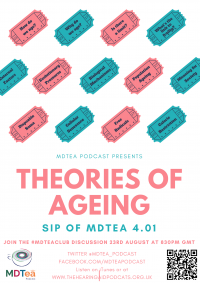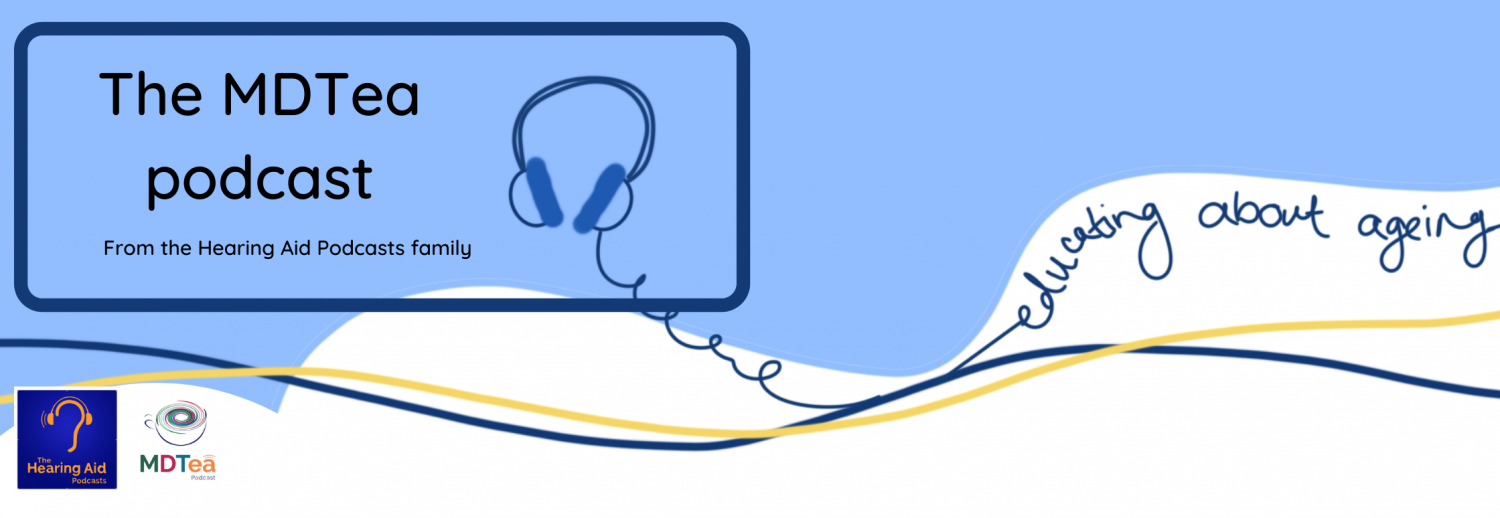4.01 Theories of Ageing
Episode 4.01 – Theories of Ageing
Presented by:
Dr Iain Wilkinson (Consultant Geriatrician East Surrey Hospital)
Dr Jo Preston (Consultant Geriatrician St George’s Hospital)
Faculty:
Sarah-Jane Ryan – Physiotherapist – University of Brighton
Sip of MDTea

Click here for the pdf of this infographic.
CPD log
Click here to log your CPD online and receive a copy by email.
Tweetchat #MDTeaClub 23rd August
Show notes
pdf of these is here
Learning Outcomes
Knowledge:
- Recall the main theories of ageing at a biological level
- Understand the difference between individual ageing and population ageing
Skills:
- To be able to distinguish normal ageing and frailty
Attitudes:
- To appreciate how normal ageing affects individuals throughout lifecourse
Definitions:
There are many ways to define ageing process (compare with discussions on frailty).
- Biological (focus of this episode)
- Sociological
- Psychological
We explored some of the latter two in episode 3.06 on Identity.
Bernhard Strehler defined ageing as needing to be:
- Universal: the process must happen to all members of a species
- Intrinsic: via endogenous processes, must not depend on extrinsic factors
- Progressive: changes leading to ageing must occur progressively throughout lifespan
- Deleterious: bad for the individual
Theories of Ageing. Vina et. al UMBM Life 2007
Practical Definition:
Virtually all physiological functions lose efficiency with ageing. I.e. lose capacity to maintain homeostasis when faced by external challenges. Also intrinsic losses leads to increases in neurodegeneration and immune system function.
Theories of Ageing. Vina et. al UMBM Life 2007
Key Points from Discussion
Population Ageing versus Individual Ageing
- Average age of populations has increased, worldwide, as the extrinsic factors are brought into control e.g. reduced infant mortality and public health interventions such as sanitation.
- This is well recognised to be continuing to increase, i.e. the overall health and life expectancy of the population.
- When we talk of an ageing population we are often talking about the average age, so there is a dependence on the ages of everyone else.
- For example if there are lots of young children and lots of older adults, the average will be in the middle.
- In western countries, decreased fertility is one contributor to the ‘ageing population’ seen from a whole scale level.
What we are interested in this episode now is: how long can we live? And why? Has that increased? And if so, why? Because that give us clues as what is happening physiologically.
What is happening now is that more people are reaching the oldest old ages, rather than the capacity of humans to live to 90 or 100 has changed. Just more of us are managing it.
Senescence
“Senescence has no function – it is the subversion of function”
from http://www.senescence.info/evolution_of_aging.html
- Cell senescence is when a cell stops dividing but remains metabolically active. Compared to apoptosis, which is cell death, followed by removal from the system. Commonly become pro-inflammatory.
- Oncogenes can induce senescence, and this is one of the commonest studied, but many other chemical and biological signals can induce it in the context of ageing, including bad proteins, genes and processes associated with cell division.
- Oncogene is: a gene that has the potential to cause cancer (unregulated cell growth). Usually they are involved in the cell division regulation and start as proto-oncogenes and need to mutate to cause a problem.
- Senescence is not just seen in the context of ageing though
- for example when a wound is healing, once it is healed, the myofibroblast cells go into acute senescence to prevent excessive fibrosis at the site.
- Or when building the blood supply for an embryo.
- Conversely in relation to ageing, it appears unscheduled and more random. Clearance of aged cells which have undergone senescence is much less efficient and this may be due to reduced immune function associated with ageing.
- Cells with senescent properties are seen in tissues of those with age-related diseases such as osteoarthritis, pulmonary fibrosis, atherosclerosis and Alzheimer’s disease. It is unclear exactly what the mechanism leading from one to the other is though.
- Cellular senescence is not seen in: lobsters, coral or perennial plants!
The role of senescent cells in ageing. Jan M. van Derusen, Nature 2014.
- Cells that become senescent cannot divide again – Termed the Hayflick limit –
- Alexis Carrel story – chicken myocytes – 20 years – cell culture
Ageing theories come in two main types:
- Those about a limitation of replication of cells
- Those looking at it from an evolutionary point of view
Theories in relation to a limitation of replication
Telomere Shortening
- Each time a cell divides, a little bit at the end of the telomere is used up.
- Telomere is like a ‘cap’ at the end of a chromosone to protect the tips of the DNA – like the plastic bit on a shoelace
- Eventually too short to continue dividing so it stops to prevent errors that may lead to errors including cancers.
Damage Accumulation Theory
- Kirkwood: Ageing is a result of accumulation of faults at cellular and molecular level due to a limitation of maintenance and repair mechanisms.
- So it isn’t the cells themselves, but the regulation of essential maintenance and repair that keep the cell division process efficient and safe.
Free Radical Theory of Ageing
- Free radicals derived from chemical reaction involving oxygen molecules (oxidation).
- This happens more in older cells than it does in younger ones.
- Species with high levels of this have short life expectancies.
- Balanced by anti-oxidants: prevents oxidative damage to elements with cells e.g. proteins, DNA and lipids all of which are vital for normal cell function.
- Mitochondrial theory of free radicals in ageing suggests that damage by reactive oxygen species (ROS), causes oxidative stress which overwhelms the anti-oxidant cellular defences. This then leads to cell senescence.
- Chronic oxidative stress through the lifespan plays a critical role in ageing overall.
- Some evidence that anti-oxidants can be applied to reduce this damage e.g. vitamin E and uric acid (note inclusion in anti-ageing creams), but no conclusive evidence that this can increase life expectancy.
Theories of Ageing. Vina et. al UMBM Life 2007
Evolutionary theories
- Based on the idea that the biological processes associated with ageing have an advantage to the group over the individual… but humans regularly live beyond reproductive age.
Disposable Soma Theory
- Example of an evolutionary theory
- An organism must budget the limited energy available to it.
- Preferentially focuses on reproduction rather than maintaining the mature body
- Therefore leading to inefficiencies in cell replication later in life.
Mutation Accumulation Theory
- Supports this idea by asserting that DNA mutations that take place after reproductive age cannot affect future generations.
- Meaning that there is no evolutionary pressure to correct it or develop protection against the defect.
Antagonistic Pleiotropy
One step further: genes protective or beneficial in early life, become detrimental later in life.
Eg. Sickle cell disease (protective against malaria).
Calorie Restriction
- Japanese Island of Okinawa – highest prevalence of centenarians in the world.
Caloric restriction, the traditional Okinawan diet and healthy aging: the diet of the the world’s longest living people and its potential impact on morbidity and life span. Wilcox et. al 2007
- Dietary restriction in mice showed increased longevity in rodents (both on average and maximally achieved).
Theories of Ageing. Vina et. al UMBM Life 2007
- Likely to be mediated by several different effects on the body including
- Reducing oxidative damage
- Anti-inflammatory effects
- Delaying onset of age related diseases in animal models
Calorie restriction as an intervention in ageing. Lopez-Lluch & Naves. Journal of Physiology 2016
Caloric restriction. Speakman & Mitchell. Molecular Aspects of Medicine 2011
How will this affect us all?
Clearly the extent to which these processes has affected the individual will determine life expectancy. Improved public health and better earlier preventative health interventions, including advancing technologies such as PCI, allow more individuals to live into later life to experience the consequences of these biological processes.
There are 3 theories of how populations age in terms of how this affects older individuals.
- Compression of morbidity (Fries)
- Expansion of morbidity (Gruenberg)
- Dynamic Equilibrium (Manton)
There is evidence for each model!
Curriculum Mapping:
This episode covers the following areas (n.b not all areas are covered in detail in this single episode):
| Curriculum | Area |
| NHS Knowledge Skills Framework | n/a |
| Higher specialist training in Geriatric Medicine | 3.2.1 Basic Science and Biology of Ageing |
| Foundation curriculum | n/a |
| Core Medical Training | n/a |
| GPVTS program | Section 3.05
|
| ANP (Draws from KSF) | n/a |




